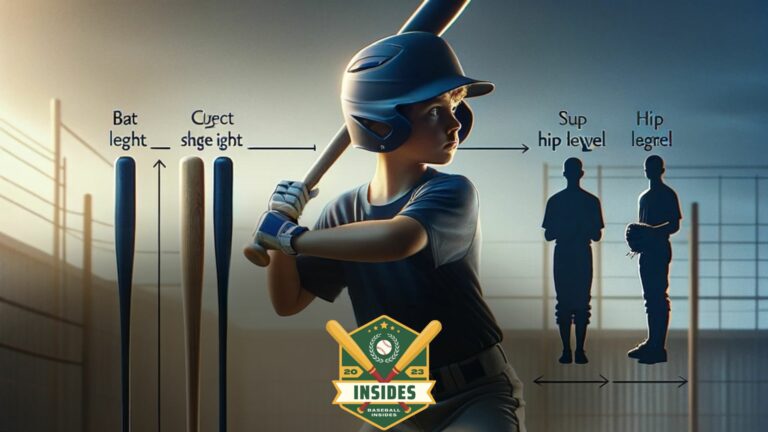
In this article:
Have you ever wondered how fast a baseball can come off the bat? Whether you’re a pro player, a college hitter, or even a high school student, understanding the speed at which a baseball leaves the bat is crucial to success on the diamond.
In professional baseball, the top batters need to connect with pitches traveling at speeds exceeding 90 mph, while the average exit speed in the big leagues hovers around an impressive 94 mph.
Meanwhile, collegiate hitters’ face pitches come in slightly slower at 91 mph. Even in high school, where the game is still developing, freshmen face velocities around 72 mph, while seniors contend with speeds up to 83 mph.
Are you curious to learn more about the fascinating dynamics of baseball bat speed? Join us as we delve deeper into the world of high-velocity hits and uncover the secrets behind this exhilarating sport.
The Need for Speed
Baseball is one of America’s favorite pastimes and is enjoyed by people of all ages. Whether you’re a player or a dedicated fan, understanding the speed at which a baseball comes off the bat can greatly impact your appreciation and enjoyment of the game.
So, why is it important to know how fast a baseball comes off the bat?
Knowing this information can give players an advantage at the plate. They can work on increasing their bat speed and timing, allowing them to hit balls harder and further.
For fans, understanding this aspect of the game can provide valuable insight into player performance and offer a whole new level of appreciation for incredible plays made on both offense and defense.
Knowing how fast a baseball travels off the bat can also provide insight into other key aspects of the game, such as pitching strategy and defensive positioning.
A fastball coming off the bat requires quick reflexes from fielders, who must be properly positioned to make successful plays.
Knowing how fast an opposing player can hit on the pitching side allows pitchers to adjust their approaches accordingly to better defend against high-speed hits.
In short, understanding how fast a baseball travels off the bat is crucial for anyone looking to have a deeper appreciation for America’s favorite pastime – whether on or off the field!
In this article, we’ll explore this topic in depth so you can become a baseball expert speed-related.
The Science Behind It
Baseball is a sport of brute force and athleticism and involves a fair amount of science and physics. When a bat hits a baseball, the collision between the two objects creates the speed with which the ball flies off the bat.
This phenomenon can be explained through basic physics principles, namely momentum and energy transfer.
The speed at which a baseball comes off the bat is determined by several factors, including bat speed, angle of contact, and ball spin.
The faster the bat speeds up before hitting the ball, the more energy it has upon impact. The angle at which the ball makes contact with the bat also plays an important role in determining how fast it will travel.
Balls that are hit square-on will travel farther than those that are hit on an angle, as they retain more energy after impact.
Spin on a ball can create additional lift or drag that affects its trajectory – this may cause it to curve or sink in flight.
Choosing the best baseball bats for 8 year olds is crucial as it can significantly impact their swing speed and the velocity at which the ball comes off the bat.
How Players Improve Bat Speed
The Quest for More Power at the Plate
For any baseball player, regardless of their position, hitting the ball with power is a key component of success.
One of the most important factors in achieving that power is bat speed.
The faster a player can swing their bat, the more momentum they generate, resulting in a faster ball speed off the bat and greater distance on their hits.
So, how do players improve their bat speed?
One common technique is to focus on increasing strength and explosiveness in their swing. This can be accomplished through weight training and other exercises targeting specific batting muscle groups.
Plyometric exercises – like jumping squats or medicine ball throws – can help build explosive power and increase overall strength in the lower body, core, and arms.
Another way to improve bat speed is using specialized equipment like weighted bats or resistance bands during practice sessions.
Weighted bats are heavier than standard bats and force players to use more effort to swing them, building strength and power over time.
Resistance bands provide added resistance during swings, helping players develop muscle memory while increasing overall strength.
Training regimens will vary depending on individual goals and needs but typically combine various techniques such as these to help players hone their skills at the plate.
Whether they are looking for increased power or better control over where they put the ball, putting time on these drills can make all the difference when stepping up to bat in game situations.
To ensure players have the competitive edge, our guide to the 10 best USSSA bats highlights top choices that can help hitters achieve faster ball exit speeds.
The Impact on Pitchers and Fielders
Faster Ball Speeds: A Challenge for Pitchers and Fielders Alike
It’s no secret that a faster ball speed can pose a challenge for pitchers and fielders alike. For pitchers, the faster the ball comes off the bat, the less time they have to react and adjust their positioning to catch or deflect it.
It’s not just about physical reflexes, either – pitchers need to have a quick mental processing speed to make split-second decisions about what type of pitch to throw next based on how the batter performs at the plate.
Fielders also face their challenges when dealing with fastballs hit by batters. They must judge where the ball goes as quickly as possible to get in position for a catch or fielding play.
This can be especially difficult if the ball has been hit with a lot of power, making it harder to predict its trajectory accurately.
Whether playing infield or outfield positions, fielders need lightning-fast reflexes combined with an innate sense of spatial awareness to make plays on high-speed balls hit by batters.
Strategies for Reacting Quickly on High-Speed Balls
So how do pitchers and fielders prepare themselves for dealing with fastballs hit off bats? One key strategy is practice – lots of it.
Pitchers work diligently on honing their reaction times during training sessions, whether through drills involving throwing against walls or working with specific hitters known for hitting at high speeds.
Fielders also put in hours of practice time perfecting their reaction times so that they’re ready for any situation that arises during gameplay.
They work on developing quick footwork to move into position quickly after a ball has been hit, as well as building strength to make quick, powerful throws to get the ball back into play. Another strategy that both pitchers and fielders use is visualization.
Mental rehearsals of different gameplay scenarios can help them better prepare for how to react in a split-second scenario when a fastball is coming their way.
Whether it’s imagining how they’ll catch or deflect the ball or rehearsing different strategies for getting in position quickly based on where the ball has been hit, visualization can help players become more confident and prepared when dealing with high-speed baseballs hit off bats.
The advanced technology and rigorous testing that go into manufacturing high-quality equipment partly explain why are baseball bats so expensive, influencing how fast a ball can be hit.

Frequently Asked Questions
How Fast Does a Ball Come Off a Bat in MLB?
The average exit velocity in Major League Baseball (MLB) is around 87 mph, while the top home run and extra-base hitters often achieve an exit velocity of 90+ mph.
How Fast Do Baseballs Go After Being Hit?
Baseballs can travel approximately 500 feet per second, equivalent to nearly six miles per minute. This speed is faster than the travel speed of any express train.
What is Baseball Exit Velocity?
Baseball exit velocity refers to the speed at which the ball leaves the bat immediately after contact is made between the bat and the ball.
What is the Exit Velocity to Hit a Home Run?
To hit a home run, players typically need a maximum exit velocity ranging from 76 to 82 mph, with an average exit velocity of around 64+.
Conclusion
In conclusion, the speed at which a baseball comes off the bat is a crucial factor in baseball, determining the success of batters at different levels of play.
To be successful in professional and college baseball, hitters need to be able to hit the ball with a minimum speed of 90 mph.
In the major leagues, the average ball exit speed is approximately 94 mph, showcasing the high skill and power exhibited by professional hitters.
Collegiate hitters, on the other hand, have a slightly lower average ball exit speed of around 91 mph.
In high school, the average ball velocity ranges from 72 mph for freshmen to 83 mph for seniors, highlighting the developmental progress of players as they advance through the high school ranks.
These statistics emphasize the importance of bat speed and power in the sport and the increasing level of competition as players advance to higher levels of play.






